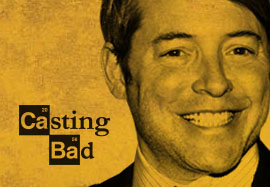
Casting Bad
 I recently read that the main character of one of arguably greatest TV dramas of all time was almost cast differently. I’m speaking, of course, about Bryan Cranston in the epic role of Walter White in AMC’s Breaking Bad. If you haven’t watched it, I don’t want to know you. But I digress. It seems that both John Cusack and Matthew Broderick, were up for the iconic role. Can you imagine either of them as that character now that you’ve seen the show? It’s fun to think about Ferris Bueller channeling his inner meth cook, or watching Cusack do his rambly stream of consciousness charming guy shtick while (spoiler alert) gunning down an army of Neo-Nazi meth dealers. However, it did get me thinking about the importance of casting, and how nailing that face, voice and presence can really bring a character to life.
I recently read that the main character of one of arguably greatest TV dramas of all time was almost cast differently. I’m speaking, of course, about Bryan Cranston in the epic role of Walter White in AMC’s Breaking Bad. If you haven’t watched it, I don’t want to know you. But I digress. It seems that both John Cusack and Matthew Broderick, were up for the iconic role. Can you imagine either of them as that character now that you’ve seen the show? It’s fun to think about Ferris Bueller channeling his inner meth cook, or watching Cusack do his rambly stream of consciousness charming guy shtick while (spoiler alert) gunning down an army of Neo-Nazi meth dealers. However, it did get me thinking about the importance of casting, and how nailing that face, voice and presence can really bring a character to life.
As the Broadcast Producer here at CultureSpan, I generally take a lead role in casting, and I take it very seriously. It may seem obvious that a campaign targeted to teens should feature teens, or that a spot aimed at adult males with receding hairlines should feature a gracefully balding gentleman. The truth is, there’s more to it than that.
The fine line between good casting and great casting is knowing the difference between simply finding talent representative of the target and finding a talent that speaks to what the target wants to see in him or herself. It’s a lesson vetted through decades of ads. In the golden age of advertising, it was a simple format. A dapper man stands for all men, and happy housewife stands for all women. Happily we’ve come a long way since then. The one thing that does remain the same is the aspirational quality that viewers want to see in the faces that bring them advertising messages. Connection is key. And as products, services and messages become more complex, so does our job in finding the right face, voice and presence. Does your talent speak to the viewer? Does your talent get results?
If that weren’t enough of a challenge, take into consideration that most of the work we do here at CultureSpan is developed for two audiences, English and Spanish speakers. Luckily we’ve had a lot of practice. And this skill set really comes in handy when casting talent. So often the question is asked, “What does a real Hispanic look like? What do they sound like?” The answer is not an easy one, mostly because we often use “Hispanic” as a catchall term. However, the diversity between a resident of Southern Mexico City and a resident of Northern Chihuahua can be as great as the differences between the cultures of say, a Cuban and Puerto Rican. This notion extends doubly when it comes to doing Spanish language voiceovers. As any transcreator worth his salt knows, not all Spanish is the same. Knowing the often-subtle differences between a neutral northern Mexico border Spanish and the accented Puerto Rican Spanish of a Florida native can make all the difference. Overlooking these differences can result in not only sounding foolish, but also might even insult your audience. Trust building is very important in many Hispanic and Latin cultures, and if you can’t speak to your intended audience not only in their language, but their dialect as well, the road to customer loyalty will be a rocky one.
So, for those of you out there in major markets with a growing Hispanic consumer base, who want your share of 1.3 trillion dollars in buying power, I say to you this; know your market, understand your consumer, educate yourself to their culture, and always lead with respect. Developing great creative and resonant messages for bi-cultural audiences is what we do best, but it is not beyond the marketer that is willing to give it the effort it deserves.
The takeaway here is that message matters, and finding the right talent is imperative. So the next time you’re ready to cast for TV, radio, or branded content for your clients, remember how thankful you are that Brian Cranston landed the role of Walter White.
Kill some time and watch these questionable casting decisions.